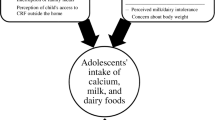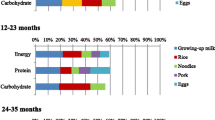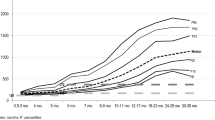Abstract
Dietary calcium sources may differ by race/ethnicity and dietary acculturation. A cross-sectional, convenience sample including 587 United States (US) Asian, Hispanic and non-Hispanic White parent–child (10–13 years) pairs completed a calcium food frequency questionnaire. Calcium sources were ranked by mean percent contribution to total adjusted calcium intake, and compared by ethnic group and parents’ location of birth. Five foods (fluid milk, cheese, milk on cereal, yogurt, and lattes) represented 49 % of total calcium intake for parents. The same foods (except lattes) represented 55 % of total calcium for early adolescent children. Fluid milk provided the largest mean percentage of intake for all race/ethnic groups among parents and children. Several food sources of calcium were greater for foreign-born versus US-born Asian or Hispanic parents and children. Understanding calcium food sources and changes in dietary patterns that affect calcium intake among parents and children is important to better promote adequate intake.
Similar content being viewed by others
References
Bailey RL, et al. Estimation of total usual calcium and vitamin D intakes in the United States. J Nutr. 2010;140:817–22.
Wallace TC, et al. Calcium and vitamin D disparities are related to gender, age, reace, household income level, and weight classification but not vegetarian status in the United States: analysis of the NHANES 2001–2008 data set. J Am Coll Nutr. 2013;32:321–30.
Abrams SA. Calcium and vitamin D requirements for optimal bone mass during adolescence. Curr Opin Clin Nutr Metab Care. 2011;14:605–9.
Chung M, et al. Vitamin D and calcium: a systematic review of health outcomes. Evid Rep Technol Assess. 2009;183:1–420.
Lanham-New S. Importance of calcium vitamin D and vitamin K for osteoporosis prevention and treatment. Proc Nutr Soc. 2008;67:163–76.
Nicklas TA, et al. The role of dairy in meeting the recommendations for shortfall nutrients in the American diet. J Am Coll Nutr. 2009;28(Suppl 1):S73–81.
Rice BH, et al. Meeting and exceeding dairy recommendations: effects of dairy consumption on nutrient intakes and risk of chronic disease. Nutr Rev. 2013;71:209–23.
Cotton PA, et al. Dietary sources of nutrients among US adults 1994 to 1996. J Am Diet Assoc. 2004;104:921–30.
Rajeshwari R, et al. Longitudinal changes in intake and food sources of calcium from childhood to young adulthood: the Bogalusa heart study. J Am Coll Nutr. 2004;23:341–50.
Satia JA. Dietary acculturation and the nutrition transition: an overview. Appl Physiol Nutr Metab. 2010;35:219–23.
Lv N, Brown JL. Place of dairy products in the Chinese-American family food system. J Am Diet Assoc. 2010;110:1207–15.
Park SY, et al. Mothers’ acculturation and eating behaviors of Korean American families in California. J Nutr Educ Behav. 2003;35:142–7.
Allen ML, et al. Adolescent participation in preventive health behaviors physical activity and nutrition: differences across immigrant generations for Asians and Latinos compared with Whites. Am J Public Health. 2007;97:337–43.
Dixon LB, et al. Differences in energy nutrient and food intakes in a US sample of Mexican-American women and men: findings from the third national health and nutrition examination survey 1988–1994. Am J Epidemiol. 2000;152:548–57.
Sebastian RS, Goldman JD, Wilkinson Enns C, LaComb RP. Fluid milk consumption in the United States: what we eat in America, NHANES 2005-2006. Food Surveys Research Group Dietary Data Brief No. 3; 2010. http://ars.usda.gov/Services/docs.htm?docid=19476.
Ayala GX, et al. A systematic review of the relationship between acculturation and diet among Latinos in the United States: implications for future research. J Am Diet Assoc. 2008;108:1330–44.
Harley K, et al. The association of time in the US and diet during pregnancy in low-income women of Mexican descent. Paediatr Perinat Epidemiol. 2005;19:125–34.
Johnson-Down L, et al. Primary food sources of nutrients in the diet of Canadian adults. Can J Diet Pract Res. 2006;67:7–13.
Jensen JK, et al. Development of a food frequency questionnaire to estimate calcium intake of Asian Hispanic and White youth. J Am Diet Assoc. 2004;104:762–9.
Yang J: Use of duplicate plate method to evaluate dietary assessment methods. Purdue University Dissertation 165 pages; AAT 3296117, 2007.
Matlik L, et al. Perceived milk intolerance is related to bone mineral content in 10- to 13-year-old adolescent females. Pediatrics. 2007;120:e669–77.
Gao X, et al. Meeting adequate intake for dietary calcium without dairy foods in adolescents aged 9 to 18 years (national health and nutrition examination survey 2001–2002). J Am Diet Assoc. 2006;106:1759–65.
U.S. Department of Agriculture and U.S. Department of Health and Human Services. Dietary guidelines for Americans. 7th ed. Washington, DC: U.S. Government Printing Office; 2010.
Sources of sodium among the US population, 2005–06. Applied research program web site. National Cancer Institute. http://appliedresearch.cancer.gov/diet/foodsources/sodium/. Updated 11 April 2014. Accessed 18 Feb 2015.
Reedy J, Krebs-Smith SM. Dietary sources of energy solid fats and added sugars among children and adolescents among children and adolescents in the United States. J Am Diet Assoc. 2010;110:1477–84.
Szilagyi A. Determinants of geographic patterns of diseases: interaction of lactose/lactase status and sunshine exposure. Med Hypotheses. 2010;75:466–70.
Whitmore AS, et al. Diet physical activity and colorectal cancer among Chinese in North America and China. J Nat Cancer Inst. 1990;82:915–26.
Weaver CM, et al. Choices for achieving adequate dietary calcium with a vegetarian diet. Am J Clin Nutr. 1999;70(Suppl):543S–8S.
Cluskey M, et al. At home and away-from-home eating patterns influencing preadolescents intake of calcium-rich foods as perceived by Asian Hispanic and non-Hispanic White parents. J Nutr Educ Behav. 2008;40:72–9.
Montez JK, Eschbach K. Country of birth and language are uniquely associated with intakes of fat fiber and fruits and vegetables among Mexican-American women in the United States. J Am Diet Assoc. 2008;108:473–80.
Sanou D et al.: Acculturation and nutritional health of immigrants in Canada: a scoping review. J Immigr Minor Health. 2014;16:24–34.
Lv N, Cason KL. Dietary pattern change and acculturation of Chinese Americans in Pennsylvania. J Am Diet Assoc. 2004;104:771–8.
Flores M, et al. Dietary patterns in Mexican adults are associated with risk of being overweight or obese. J Nutr. 2010;140:1869–73.
Suarez L, Pulley L. Comparing acculturation scales and their relationship to cancer screening among older Mexican-American women. J Nat Cancer Inst Monogr. 1995;18:41–7.
Cuéllar I, et al. Acculturation rating scale for Mexican Americans-II: a revision of the original ARSMA scale. Hisp J Behav Sci. 1995;17:275–304.
Satia JA, et al. Psychosocial predictors of diet and acculturation in Chinese American and Chinese Canadian women. Ethn Health. 2002;7:21–39.
Liou D, Contento IR. Usefulness of psychosocial theory variables in explaining fat-related dietary behavior in Chinese Americans: association with degree of acculturation. J Nutr Educ. 2001;33:322–31.
Smokowski PR, et al. Acculturation and adolescent health: moving the field forward. J Prim Prev. 2009;30:209–14.
Siris ES, et al. Identification and fracture outcomes of undiagnosed low bone mineral density in postmenopausal women: results from the national osteoporosis risk assessment. J Am Med Assoc. 2001;286:2815–22.
Acknowledgments
This project was funded with money appropriated by Congress through the Hatch Act to Agricultural Experiment Stations of land grant universities for multistate research projects.
Author information
Authors and Affiliations
Corresponding author
Rights and permissions
About this article
Cite this article
Cluskey, M., Wong, S.S., Richards, R. et al. Dietary Sources of Calcium Among Parents and Their Early Adolescent Children in the United States by Parent Race/Ethnicity and Place of Birth. J Immigrant Minority Health 17, 432–440 (2015). https://doi.org/10.1007/s10903-014-0026-7
Published:
Issue Date:
DOI: https://doi.org/10.1007/s10903-014-0026-7




